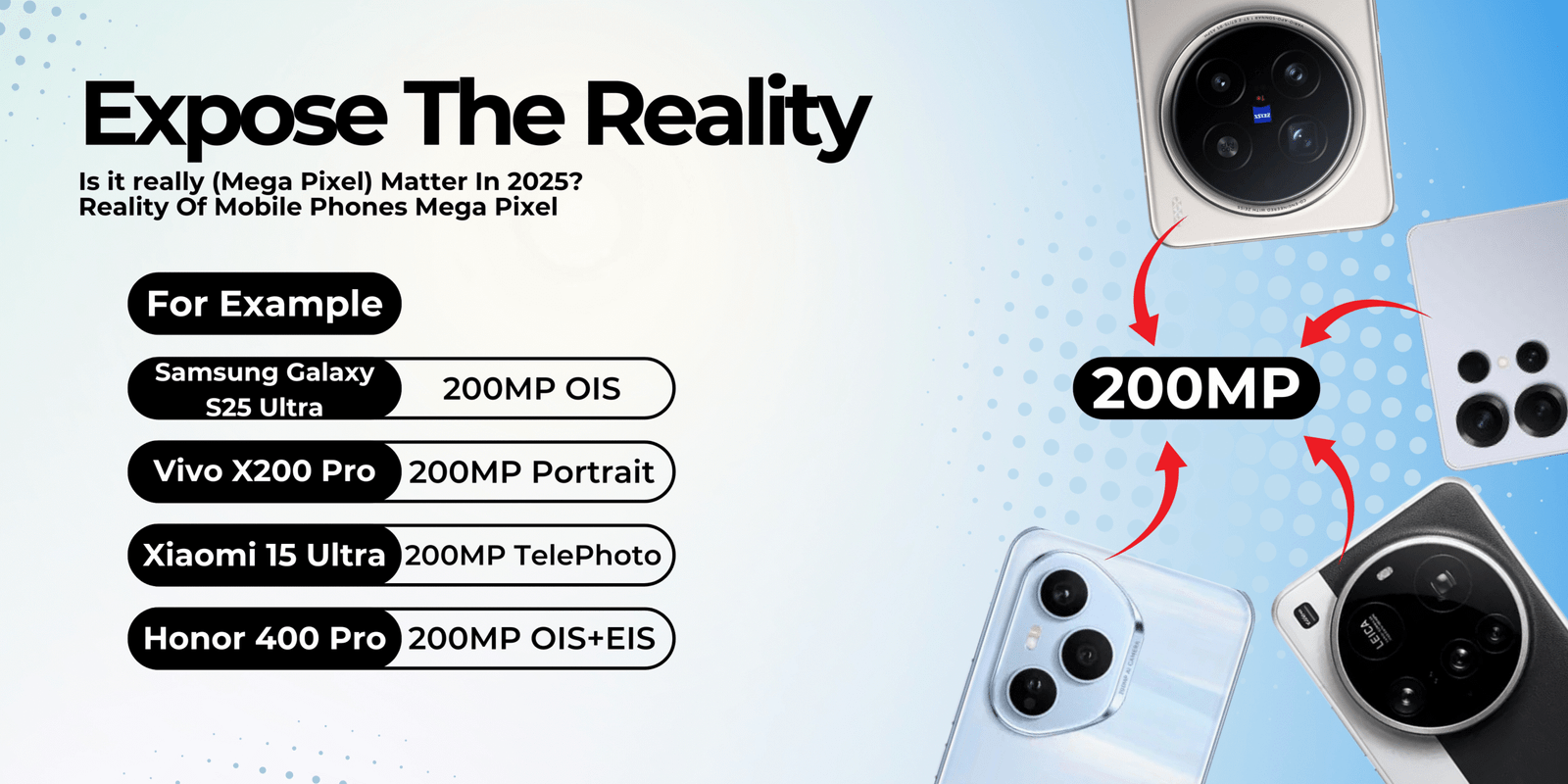📸 200MP+ Camera Phones – How Much Is Real, How Much Is Just Hype?

🎯 Introduction
In recent years, smartphone brands have been racing to add jaw-dropping numbers to their camera specs — and nothing grabs attention like a “200MP” or even “108MP” camera sensor on the box.
But here’s the real question:
Does having 200MP+ actually make your photos better? Or is it just marketing hype?
Let’s break down what 100MP+ camera phones are really offering, and whether they truly deliver DSLR-level photography — or just bigger numbers.
📷 What Does 200MP+ Really Mean?
When a phone claims it has a 200MP or 108MP camera, it means the sensor can capture images with 200+ million pixels. More pixels = more detail, right?
Well, not always.
Smartphones often use a technique called “pixel binning”, where 4, 9, or even 16 pixels are combined into one to improve low-light performance and dynamic range. So even though the sensor is 200MP, your photo might be saved at 12MP or 16MP.
🔍 Pros of 200MP+ Cameras
✅ Insane Detail
If lighting is perfect, you can crop deep into a 200MP+ photo and still get sharp results — great for landscapes or product shots.
✅ Pixel Binning Boosts Low Light
Modern 200MP sensors use 9-in-1 or 16-in-1 pixel binning, improving night photography and reducing noise.
✅ Better Zoom Quality
High-res sensors allow for lossless digital zoom up to 2x or 3x — helpful when there’s no telephoto lens.
✅ Pro-Level Editing
If you’re into editing RAW images, the extra data helps tweak shadows, highlights, and sharpness more easily.
⚠️ The Hidden Truth / Limitations
❌ File Size is Huge
100MP photos can be 25MB to 80MB in size — they eat storage quickly and slow down your gallery loading.
❌ Requires Perfect Lighting
In low light, these sensors can actually perform worse without proper pixel binning. Don’t expect miracles in dim conditions.
❌ Just Numbers, No Magic
The image quality still depends on lens quality, image processing, and sensor size. A 50MP Sony sensor might outperform a cheap 200MP sensor.
❌ Slow Shot Processing
In some phones, clicking in full 200MP mode can take a few seconds to save the photo.
📱 Popular Phones With 200MP+ Cameras (2025)
| Phone | Camera Sensor | MP Count | Special Features |
|---|---|---|---|
| Samsung Galaxy S25 Ultra | 200MP | 200MP | Laser focus, 8K video OIS |
| Xiaomi 15 Ultra | 200MP | 200MP | Leica optics, AI scene detection Telephoto |
| Vivo X200 Pro | 200MP | 200MP | Periscope zoom, |
| Honor 400 Pro | 200MP | 200MP | OIS+EIS |
🎥 Real-World Use Cases
✅ Great For:
- Landscape photography
- Daylight shots
- Cropping without quality loss
- Sharing high-res prints
❌ Not Ideal For:
- Night photography (without pixel binning)
- Fast-moving objects
- Low-end phones with poor processing
🆚 200MP+ vs 50MP: Bigger Is Not Always Better
In 2025, many flagships with 50MP sensors (like Sony IMX890 or IMX989) offer better real-world photos due to superior optics and image processing. A lower megapixel count with a larger sensor and better lens can outperform a high-MP sensor with cheap hardware.
🏁 Final Verdict – Is It Hype or Real?
📌 200MP+ camera phones are not fake — but they’re not magic either.
If the phone has a good image processor (like Snapdragon 8 Gen 3/4) and optimized software (e.g., Samsung, Xiaomi-Leica), a 200MP+ sensor can be fantastic.
But don’t be fooled: Megapixels are just one part of the photography game. Real image quality comes from a balanced combination of sensor size, optics, software, and AI tuning.
So yes — it’s partly truth, partly show. Choose wisely!





Your blog is a testament to your passion for your subject matter. Your enthusiasm is infectious, and it’s clear that you put your heart and soul into every post. Keep up the fantastic work!
Hi Neat post Theres an issue together with your web site in internet explorer may test this IE still is the marketplace chief and a good component of people will pass over your fantastic writing due to this problem
Your writing has a way of making even the most complex topics accessible and engaging. I’m constantly impressed by your ability to distill complicated concepts into easy-to-understand language.
My brother suggested I might like this blog He was totally right This post actually made my day You can not imagine simply how much time I had spent for this info Thanks
Hey there You have done a fantastic job I will certainly digg it and personally recommend to my friends Im confident theyll be benefited from this site
Somebody essentially lend a hand to make significantly articles Id state That is the very first time I frequented your website page and up to now I surprised with the research you made to make this actual submit amazing Wonderful task
Ive read several just right stuff here Certainly price bookmarking for revisiting I wonder how a lot effort you place to create this kind of great informative website
Your blog is a testament to your dedication to your craft. Your commitment to excellence is evident in every aspect of your writing. Thank you for being such a positive influence in the online community.
Your writing has a way of resonating with me on a deep level. I appreciate the honesty and authenticity you bring to every post. Thank you for sharing your journey with us.
Your articles never fail to captivate me. Each one is a testament to your expertise and dedication to your craft. Thank you for sharing your wisdom with the world.
Hi i think that i saw you visited my web site thus i came to Return the favore I am attempting to find things to improve my web siteI suppose its ok to use some of your ideas
Your blog is a beacon of light in the often murky waters of online content. Your thoughtful analysis and insightful commentary never fail to leave a lasting impression. Keep up the amazing work!
Usually I do not read article on blogs however I would like to say that this writeup very compelled me to take a look at and do so Your writing taste has been amazed me Thanks quite nice post
Usually I do not read article on blogs however I would like to say that this writeup very compelled me to take a look at and do it Your writing style has been amazed me Thank you very nice article
Thank you for the auspicious writeup It in fact was a amusement account it Look advanced to more added agreeable from you By the way how could we communicate
Your blog is a breath of fresh air in the often mundane world of online content. Your unique perspective and engaging writing style never fail to leave a lasting impression. Thank you for sharing your insights with us.
helloI really like your writing so a lot share we keep up a correspondence extra approximately your post on AOL I need an expert in this house to unravel my problem May be that is you Taking a look ahead to see you
I loved as much as you will receive carried out right here The sketch is attractive your authored material stylish nonetheless you command get got an impatience over that you wish be delivering the following unwell unquestionably come more formerly again since exactly the same nearly a lot often inside case you shield this hike
I loved as much as you will receive carried out right here The sketch is attractive your authored material stylish nonetheless you command get got an impatience over that you wish be delivering the following unwell unquestionably come more formerly again since exactly the same nearly a lot often inside case you shield this hike
Your blog is a constant source of inspiration for me. Your passion for your subject matter is palpable, and it’s clear that you pour your heart and soul into every post. Keep up the incredible work!
obviously like your website but you need to test the spelling on quite a few of your posts Several of them are rife with spelling problems and I to find it very troublesome to inform the reality on the other hand Ill certainly come back again
Your writing is like a breath of fresh air in the often stale world of online content. Your unique perspective and engaging style set you apart from the crowd. Thank you for sharing your talents with us.
I loved as much as you will receive carried out right here The sketch is attractive your authored material stylish nonetheless you command get got an impatience over that you wish be delivering the following unwell unquestionably come more formerly again since exactly the same nearly a lot often inside case you shield this hike
Your blog is a treasure trove of valuable insights and thought-provoking commentary. Your dedication to your craft is evident in every word you write. Keep up the fantastic work!
you are in reality a just right webmaster The site loading velocity is incredible It seems that you are doing any unique trick In addition The contents are masterwork you have performed a wonderful task on this topic